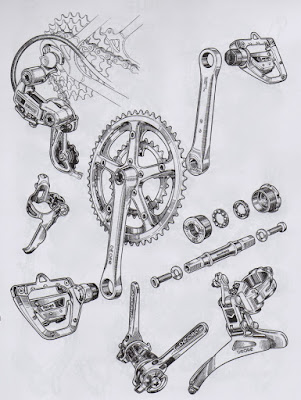You've probably heard of "storm chasers". They're the folks who pursue hurricanes, tornadoes and such, and sometimes fly into them.
You might say that yesterday, I was the opposite of a "storm chaser". Instead of riding into the storm, I wanted to finish my ride just in front of it.
Actually, I just wanted to get a ride in with the limited time I had because I woke up late and had a couple of things to take care of. I could have skipped riding, I suppose, but I have felt so sedentary and indoor-bound lately.
Late in the afternoon, according to the weather forecasts, we were supposed to have thunderstorms with strong winds and possibly hail. Now, I don't mind riding in the rain unless it's cold, but I try to avoid conditions that were predicted.
I alighted for the Rockaways at 1pm. I figured I could make it at least to Rockaway Beach and back before the deluge.
Even if you haven't spent a lot of time seaside, you could tell, from looking at the clouds that the weather was going to take a turn for the worse. And the wind coming off the ocean wasn't merely brisk; it had the edge and that weightless feeling of "butterflies in the stomach" that signals approaching bad weather.
Well, I did manage to have a light late lunch by the beach and make it home before the rain came. Although it fell steadily for a time, and the wind blew my bedroom door open, we didn't get any hail, there were no rumbles of thunder and lightning didn't blaze the sky, which remained as gray as I saw it at Rockaway Beach.
Oh well. I guess that instead of being a reverse storm-chaser, I played chicken with the rain, again.
You might say that yesterday, I was the opposite of a "storm chaser". Instead of riding into the storm, I wanted to finish my ride just in front of it.
Actually, I just wanted to get a ride in with the limited time I had because I woke up late and had a couple of things to take care of. I could have skipped riding, I suppose, but I have felt so sedentary and indoor-bound lately.
Late in the afternoon, according to the weather forecasts, we were supposed to have thunderstorms with strong winds and possibly hail. Now, I don't mind riding in the rain unless it's cold, but I try to avoid conditions that were predicted.
I alighted for the Rockaways at 1pm. I figured I could make it at least to Rockaway Beach and back before the deluge.
Even if you haven't spent a lot of time seaside, you could tell, from looking at the clouds that the weather was going to take a turn for the worse. And the wind coming off the ocean wasn't merely brisk; it had the edge and that weightless feeling of "butterflies in the stomach" that signals approaching bad weather.
Well, I did manage to have a light late lunch by the beach and make it home before the rain came. Although it fell steadily for a time, and the wind blew my bedroom door open, we didn't get any hail, there were no rumbles of thunder and lightning didn't blaze the sky, which remained as gray as I saw it at Rockaway Beach.
Oh well. I guess that instead of being a reverse storm-chaser, I played chicken with the rain, again.






